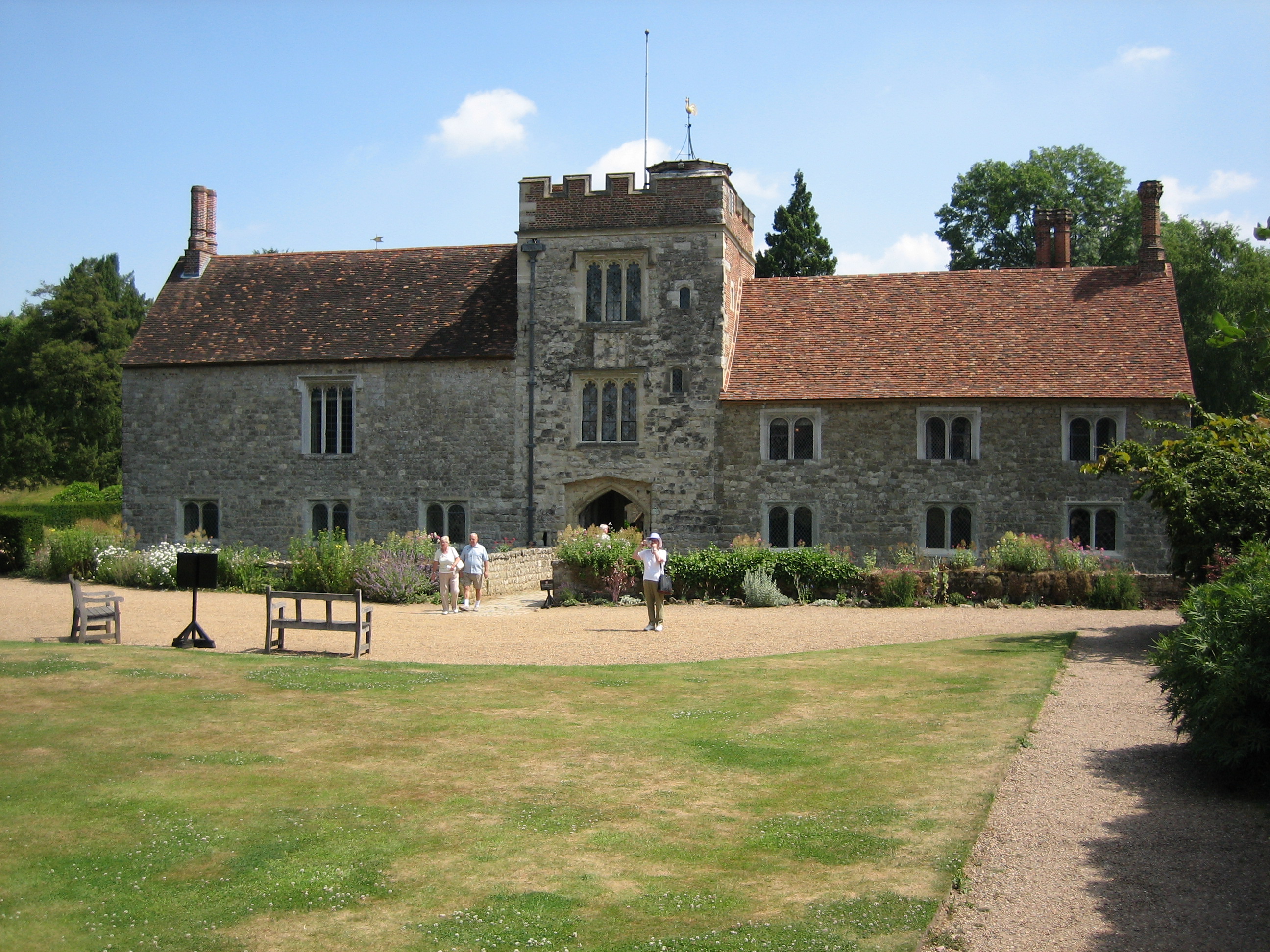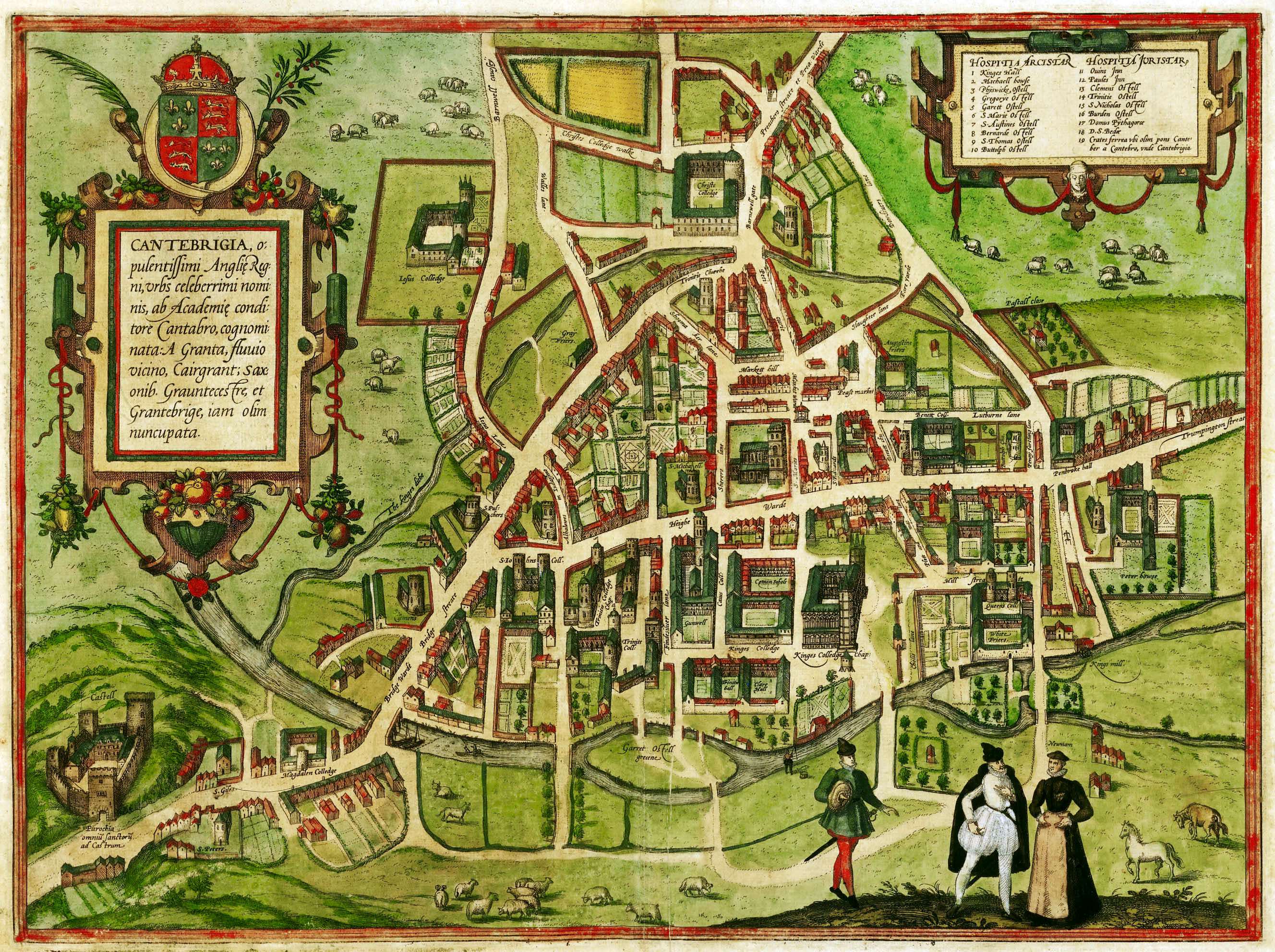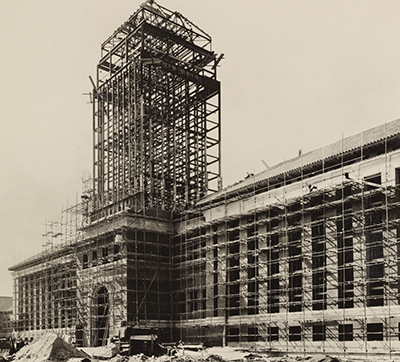|
Moot Hall, Steeple Bumpstead
The Moot Hall, also known as the Old School House, is a former market hall and school on Church Street in Steeple Bumpstead, Essex, England. The building, which now operates as a library and parish meeting room, is a Grade II* listed building. History The building was commissioned as a market hall by the wealthy villagers of Steeple Bumpstead in the late 16th century. It was designed in the Tudor style using timber frame construction, and was completed in 1592. The design involved a broadly symmetrical main frontage of three bays facing northeast down Chapel Street. The first floor involved extensive use of jettied timber framing allowing the creation of extra space for the meeting room on that floor. The ground floor was originally open but it was enclosed in the 18th century. On the first floor, there was a prominent tri-partite casement window. On the northwest side, there was an external staircase which was also encased in the 18th century. At roof level there is a hip roof ... [...More Info...] [...Related Items...] OR: [Wikipedia] [Google] [Baidu] |
Steeple Bumpstead
Steeple Bumpstead is a village and civil parish south of Haverhill, Suffolk, Haverhill in Braintree (district), Braintree district, Essex, England. The parish church does not have a steeple, although the Congregational Church has a small Victorian era, Victorian one. It is believed that the steeple referred to was located on the A1017 close to what is now the Wixoe Pumping Station. Village features include a village hall, School (Steeple Bumpstead Primary school) and park. Etymology The name ''Bumpstead'', once referring to the whole area now known as Steeple and Helions Bumpstead, is first attested in a charter of 1042—albeit only in a copy of the mid-twelfth century—as ''Bumsted'' and ''Bumsteda''; it next appears in the Domesday Book of 1086 (in the spellings ''Bumesteda'', ''Bummesteda'', and ''Bunsteda''). The first element of the name is agreed probably to have been the Old English word ''bune'', in this context meaning 'reeds' (though it could also mean 'flax' or 'he ... [...More Info...] [...Related Items...] OR: [Wikipedia] [Google] [Baidu] |
Lord Of The Manor
Lord of the manor is a title that, in Anglo-Saxon England and Norman England, referred to the landholder of a historical rural estate. The titles date to the English Feudalism, feudal (specifically English feudal barony, baronial) system. The lord enjoyed Manorialism, manorial rights (the rights to establish and occupy a residence, known as the manor house and demesne) as well as seignory, the right to grant or draw benefit from the estate (for example, as a landlord). The title is not a peerage or title of upper nobility (although the holder could also be a peer) but was a relationship to land and how it could be used and those living on the land (tenants) may be deployed, and the broad estate and its inhabitants administered. The title continues in modern England and Wales as a legally recognised form of property that can be held independently of its historical rights. It may belong entirely to one person or be a moiety title, moiety shared with other people. The title is know ... [...More Info...] [...Related Items...] OR: [Wikipedia] [Google] [Baidu] |
Grade II* Listed Buildings In Braintree (district)
There are over 20,000 Grade II* listed buildings in England. This page is a list of these buildings in the district of Braintree in Essex Essex ( ) is a Ceremonial counties of England, ceremonial county in the East of England, and one of the home counties. It is bordered by Cambridgeshire and Suffolk to the north, the North Sea to the east, Kent across the Thames Estuary to the .... List of buildings See also Grade I listed buildings in Braintree Notes External links {{DEFAULTSORT:Braintree * Lists of Grade II* listed buildings in Essex ... [...More Info...] [...Related Items...] OR: [Wikipedia] [Google] [Baidu] |
Domesday Book
Domesday Book ( ; the Middle English spelling of "Doomsday Book") is a manuscript record of the Great Survey of much of England and parts of Wales completed in 1086 at the behest of William the Conqueror. The manuscript was originally known by the Latin name , meaning "Book of Winchester, Hampshire, Winchester", where it was originally kept in the royal treasury. The ''Anglo-Saxon Chronicle'' states that in 1085 the king sent his agents to survey every shire in England, to list his holdings and dues owed to him. Written in Medieval Latin, it was Scribal abbreviation, highly abbreviated and included some vernacular native terms without Latin equivalents. The survey's main purpose was to record the annual value of every piece of landed property to its lord, and the resources in land, labour force, and livestock from which the value derived. The name "Domesday Book" came into use in the 12th century. Richard FitzNeal wrote in the ( 1179) that the book was so called because its de ... [...More Info...] [...Related Items...] OR: [Wikipedia] [Google] [Baidu] |
Cambridge
Cambridge ( ) is a List of cities in the United Kingdom, city and non-metropolitan district in the county of Cambridgeshire, England. It is the county town of Cambridgeshire and is located on the River Cam, north of London. As of the 2021 United Kingdom census, the population of the City of Cambridge was 145,700; the population of the wider built-up area (which extends outside the city council area) was 181,137. (2021 census) There is archaeological evidence of settlement in the area as early as the Bronze Age, and Cambridge became an important trading centre during the Roman Britain, Roman and Viking eras. The first Town charter#Municipal charters, town charters were granted in the 12th century, although modern city status was not officially conferred until 1951. The city is well known as the home of the University of Cambridge, which was founded in 1209 and consistently ranks among the best universities in the world. The buildings of the university include King's College Chap ... [...More Info...] [...Related Items...] OR: [Wikipedia] [Google] [Baidu] |
Cambridge University Library
Cambridge University Library is the main research library of the University of Cambridge. It is the largest of over 100 libraries Libraries of the University of Cambridge, within the university. The library is a major scholarly resource for members of the University of Cambridge and external researchers. It is often referred to within the university as the UL. Thirty-three Libraries of the University of Cambridge#Affiliated Libraries, faculty and departmental libraries are associated with the University Library for the purpose of central governance and administration, forming "Cambridge University Libraries". Cambridge University Library is one of six legal deposit libraries under UK law. It holds about 9 million items (including maps and sheet music) and, through legal deposit, purchase and donation it receives around 100,000 items every year. The University Library is unique among the legal deposit libraries in keeping a large proportion of its material on open access and in ... [...More Info...] [...Related Items...] OR: [Wikipedia] [Google] [Baidu] |
World War I
World War I or the First World War (28 July 1914 – 11 November 1918), also known as the Great War, was a World war, global conflict between two coalitions: the Allies of World War I, Allies (or Entente) and the Central Powers. Fighting took place mainly in European theatre of World War I, Europe and the Middle Eastern theatre of World War I, Middle East, as well as in parts of African theatre of World War I, Africa and the Asian and Pacific theatre of World War I, Asia-Pacific, and in Europe was characterised by trench warfare; the widespread use of Artillery of World War I, artillery, machine guns, and Chemical weapons in World War I, chemical weapons (gas); and the introductions of Tanks in World War I, tanks and Aviation in World War I, aircraft. World War I was one of the List of wars by death toll, deadliest conflicts in history, resulting in an estimated World War I casualties, 10 million military dead and more than 20 million wounded, plus some 10 million civilian de ... [...More Info...] [...Related Items...] OR: [Wikipedia] [Google] [Baidu] |
Moyns Park
Moyns Park is a Grade I Listed building, listed English country house, country house in Steeple Bumpstead, Essex. History The home of the Gent family, until the late 19th century, was once owned by Major-General Cecil Robert St John Ives, maternal grandfather of John Pablo Bryce#Marriage and issue, Ivar Bryce, the next owner. Bryce was a close friend of the author Ian Fleming, who stayed at the house in the summer of 1956. When Bryce's wife, Josephine Hartford Bryce, Josephine Hartford, an A&P heiress and sister of Huntington Hartford, died in 1992, she left the estate to Lord Ivar Mountbatten and George Mountbatten, 4th Marquess of Milford Haven. Ivar Bryce's first cousin Janet Mercedes Francis Bryce, Bryce had been married to David Mountbatten and was the mother of Ivar and George Mountbatten. Lord Ivar Mountbatten lived in the house with his wife, Penny Mountbatten, Penelope Thompson, before selling it in 1997. It is said that Fleming made final changes to his novel ''From ... [...More Info...] [...Related Items...] OR: [Wikipedia] [Google] [Baidu] |
Royal Coat Of Arms Of The United Kingdom
The royal coat of arms of the United Kingdom, also referred to as the royal arms, are the arms of dominion of the British monarch, currently Charles III. They are used by the Government of the United Kingdom and by other The Crown, Crown institutions, including courts in the United Kingdom and Coat of arms of the United Kingdom#Commonwealth usage, in some parts of the Commonwealth of Nations, Commonwealth. Difference (heraldry), Differenced versions of the arms are used by members of the British royal family. The monarch's official flag, the Royal Standard of the United Kingdom, royal standard, is the coat of arms in flag form. There are two versions of the coat of arms. One is used in Scotland, and includes elements derived from the Coat of arms of Scotland, coat of arms of the Kingdom of Scotland, and the other is used elsewhere and includes elements derived from the Coat of arms of England, coat of arms of the Kingdom of England. The shields of both versions of the arms Quart ... [...More Info...] [...Related Items...] OR: [Wikipedia] [Google] [Baidu] |
Tudor Architecture
The Tudor architectural style is the final development of medieval architecture in England and Wales, during the Tudor period (1485–1603) and even beyond, and also the tentative introduction of Renaissance architecture to Britain. It followed the Late Gothic Perpendicular style and, gradually, it evolved into an aesthetic more consistent with trends already in motion on the continent, evidenced by other nations already having the Northern Renaissance underway Italy, and especially French Renaissance architecture, France already well into its revolution in art, architecture, and thought. A subtype of Tudor architecture is Elizabethan architecture, from about 1560 to 1600, which has continuity with the subsequent Jacobean architecture in the early Stuart period. In the much more slow-moving styles of vernacular architecture, "Tudor" has become a designation for half-timbering, half-timbered buildings, although there are cruck and frame houses with half-timbering that consi ... [...More Info...] [...Related Items...] OR: [Wikipedia] [Google] [Baidu] |
Apex (geometry)
In geometry, an apex (: apices) is the vertex which is in some sense the "highest" of the figure to which it belongs. The term is typically used to refer to the vertex opposite from some " base". The word is derived from the Latin for 'summit, peak, tip, top, extreme end'. The term apex may be used in different contexts: * In an isosceles triangle, the apex is the vertex where the two sides of equal length meet, opposite the unequal third side. * In a pyramid or cone In geometry, a cone is a three-dimensional figure that tapers smoothly from a flat base (typically a circle) to a point not contained in the base, called the '' apex'' or '' vertex''. A cone is formed by a set of line segments, half-lines ..., the apex is the vertex at the "top" (opposite the base). In a pyramid, the vertex is the point that is part of all the lateral faces, or where all the lateral edges meet. References Parts of a triangle Polyhedra {{elementary-geometry-stub ... [...More Info...] [...Related Items...] OR: [Wikipedia] [Google] [Baidu] |
Hip Roof
A hip roof, hip-roof or hipped roof, is a type of roof where all sides slope downward to the walls, usually with a fairly gentle slope, with variants including Tented roof, tented roofs and others. Thus, a hipped roof has no gables or other vertical sides to the roof. A square hip roof is shaped like a pyramid. Hip roofs on houses may have two triangular sides and two Trapezoid, trapezoidal ones. A hip roof on a rectangular plan has four faces. They are almost always at the same pitch or slope, which makes them symmetrical about the centerlines. Hip roofs often have a consistent level fascia (architecture), fascia, meaning that a gutter can be fitted all around. Hip roofs often have dormer slanted sides. Construction Hip roofs can be constructed on a wide variety of plan shapes. Each ridge is central over the rectangle of the building below it. The triangular faces of the roof are called the hip ends, and they are bounded by the hips themselves. The "hips" and hip rafters ... [...More Info...] [...Related Items...] OR: [Wikipedia] [Google] [Baidu] |






